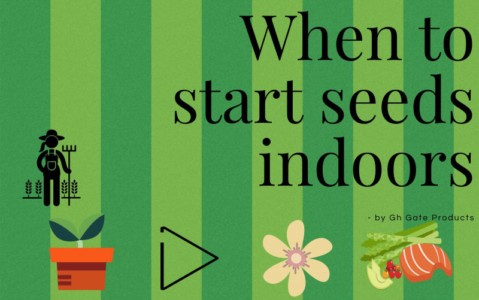When to Start Seeds Indoors
Don’t get behind the proverbial garden glass viewing ball; know when it’s time to start seeds indoors. It’s that time of year again…Or is it? Keeping up with what seeds need to be started when, and how to go about it, can be a bit tricky. In this article, we’ll review the basics so that your indoor seed starting plans can be a success this year!
Why do I need to start seeds indoors?
The reason why you may want to start your seeds inside is that most seeds require a consistent, warm environment in order to germinate and grow strong roots.
If you were to start these seeds outside, the cooler temperatures could lead to early seedling death because of disease. Excess heat could also leave your potting mix completely dry, also leading to seedling death.
For these same reasons, you’ll also want to take extra care when starting your seeds indoors. Windowsills should be avoided because the temperatures and lights are more difficult to control.
The light will also shine through from the side, rather than above, which will encourage bent stems. But, knowing where to start your seeds is really just the beginning.
When do I need to start planting my seeds?
The chart below will help you figure out when your flower/vegetable seeds need to be started indoors. Lisianthus, for instance, should be started inside around Mid-January and they will require between 16 and 17 weeks of growth inside before you can transplant them.

Where to Place Growing Seedlings
When determining where your seedlings should be placed within your home, choose a location out of reach of pets and in a place where excess heat or cold drafts won’t be a problem. You can even use your basement, given that the air temperature is above 60°F and bottom heat is provided.
What Containers to use for Seedlings
You should start your seeds inside of small containers with one for each seed. Rather than using a large container and putting many seeds into one container where the roots can grow into each other, it’s best to use a container that is divided with multiple cells.
Onions and leeks are an exception to this rule because they can be started in one large and flat container and then be transplanted while still small.
You can find plastic sheets of small containers, which are known as “cell flats”, that will fit into a standard solid tray. You can also use small plastic pots. However, all of the containers you use for seed starting need to have drainage holes punched through the bottom.
Dangers of Containers to Start Seeds Indoors
Most seed-starting containers you find are reusable, if they are made of plastic. However, they may harbor plant pathogens after they have been used once. For the health of your future seedlings, you should always sterilize containers after use by soaking the cleaned cups in a solution of disinfectant (like bleach) for 30 minutes.
Rinse and then reuse them. You can also find fiber pots that use organic materials, such as cow manure, shredded wood, or peat. Many gardeners also use strips of newspaper to make pots.
These paper/fiber pots will break down once placed in the soil, and they’re really great for raising seedlings that don’t tend to transplant well (like cucumbers and squash).
There are also clear plastic domes that can fit over your trays. These will allow the light to come in while also keeping moisture from escaping. They’ll also help retain the heat that’s provided to the root zone.
Once your seedlings are tall enough to touch it, you’ll need to remove the dome.
Choosing Seeds
When it comes to choosing what to plant, there are a few things you’ll want to keep in mind.
You can purchase seeds from your local garden center, from a building supply store, or even a mail order catalog. Prices vary widely with newer hybrids having higher price points, similar to unusual and rare plants.
Certified organic seeds will also cost more. When it comes to name-brand seed packets, you’ll likely find that the planting and care information provided on the packet is more complete.
If you are choosing between a name brand or off brand variety for the same flower or vegetable, the end plant quality should be the same regardless of the logo stamped on the packet.
This is because the germination percentage and seed purity standards are governed by law, and these laws are the same for all brands.
You’ll find sizes of seed packets also range, from mini-packets with as little as ten seeds to packets that are sold by the pound. You’ll find that purchasing smaller quantities costs more on a per-seed basis, but don’t buy more seeds than you intend to use over the next two or three years.
Does it Matter How Old the Seeds Are?
Inside each seed, there is a plant embryo that has to stay alive until it’s allowed to germinate. Using fresher seeds gives you increased chances that the seeds inside the packet will be viable. As time goes by, fewer and fewer seeds within a packet will be capable of germinating.
However, you can save any leftover seeds you have for next year. When you’re finished planting this year, store your seed packets in a cool place inside of an air-tight container (like in the refrigerator).
Use a packet of silica gel to keep down the humidity levels inside the container, and add a piece of facial tissue with a teaspoon of powdered milk inside to absorb moisture.
Sowing Seeds
Once you have determined an excellent location for your seedlings to develop, you need to grab your containers and sow your fresh seeds into them individually, according to the directions on the package.
You you don’t know how deep to plan them, a good rule of thumb is to go four times as deep as the seed is wide. Plant it deep enough so that three more seeds could be stacked above it. Always mark your containers with a tag.
If you happen to be using older seeds, which have lower germination rates, you should plant at least two seeds in each cell. After your seedlings have grown true leaves, you should cut all but the healthiest one off (at ground level) using sharp scissors.
If you try to pull them out or separate them, you’ll likely damage the one you want to keep.
Consider the requirements of your seeds, as many require light to germinate. If they require darkness, cover them with multiple sheets of newspaper or place them into dark colored plastic bags.
What is the Best Light for Starting Seeds Indoors?
Light is a very important aspect to starting seeds inddors. It’s actually a better choice to use fluorescent lighting than to try and rely solely on natural light, which isn’t exactly plentiful indoors (or even in a greenhouse setting).
You don’t have to get special “grow lights” for your plants and, in fact, any standard fixture with two “cool white” fluorescent tubes will provide adequate light for each of your seedlings. Plus, they’re inexpensive!
If you combine natural daylight and cool white tubes, your plants will get off to a great start. Be sure to hang your lights from chains so that you can raise their position up easily as your seedlings grow.
They should be no more than 4 inches above your seedlings (closer to 2 inches is perfect). Elongated, skinny stems are primarily caused by lack of light.
Your plants should get between 12 and 16 hours of light each and every day, but don’t let your lights burn continuously as most plants also require darkness at night in order to properly develop. Using a simple outlet timer can make things easy.
Bottom Heat for Seedlings
When you start seeds indoors, it can be beneficial to provide some bottom heat, or a constant source of warmth from underneath them. Your potting mix’s temperature can be as much as 5°F more than the air temperature.
Typically, using bottom heat will encourage quicker germination and healthier roots. It can also help prevent “damping off” (where seedlings die because of pathogens at the potting mix’s surface).
You can find electric heating mats made for this purpose at just about any gardening center. Don’t put your heat mats into a timed outlet!
Healthy Soil for Starting Seeds Indoors
You should keep the potting mix moist during the germination process. You can utilize a spray bottle so that you can gently wet the surface without washing the soil out of your containers. You can also add water to your trays and allow it to move upwards in the mix. Always drain excess water with either method to promote healthy roots.
Your seedlings do not need fertilizer until several sets of true leaves have developed. That’s because they draw their energy from the nutrients stored within the seed.
If you are growing your seedlings in a soil-less environment, you can use a weak, water-soluable, general purpose fertilizer (mixed at ¼ strength). Only fertilize them once a week, then water as needed.
Transplanting
When your seedlings outgrow your cell packs, it’s important that you transplant them into larger containers. Styrofoam/plastic cups with holes punched through the bottom are perfect for transplanting your seedlings.
You should always lift your seedlings by the rootball using a plant tag or spoon to support them when needed. Don’t ever hold a seedling by its stem.
Add lights as necessary while your seedlings continue growing.
How to Transition Seedlings Into The Garden
It’s important to realize that seedlings started indoors haven’t been exposed to wind, sun, or widely fluctuating temperatures.
You’ll need to put them through the process known as “hardening off” to acclimate them to the outdoors gradually. Otherwise, their leaves can be scorched by the sun or the wind. They could even wilt or die.
So, about two weeks before you plant your starters outside, you’ll want to harden them off by moving them outside for increasingly longer time periods each day.
Start with a few hours in a shady spot on your deck during the warmest hours of the day, and choose a spot out of the wind. Bring them back in before nightfall, when the temperatures will start to drop.
Leave them out for a little longer each day and expose them to a bit more sunshine gradually as you continue this process.
After two weeks, unless the forecast is showing freezing temperatures, you can leave your seedlings outside in a sunny area until they’re ready to finally be transplanted into your garden. You should transplant on a cloudy day or when the sun is past its peak for the best results.
Make sure to maintain control over pests with natural pest control to keep from damaging the plant and also to grow safe vegetables for human consumption.


Recent Comments
Original EZGT001 Gate Latch Pull In Black
Original EZGT001 Gate Latch Pull In Black
Original EZGT001 Gate Latch Pull In Black
Original EZGT001 Gate Latch Pull In Black
Original EZGT001 Gate Latch Pull In Black